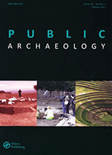
Public Archaeology
Scope & Guideline
Innovating Connections Between Scholars and Society
Introduction
Aims and Scopes
- Community Engagement and Participation:
The journal emphasizes the importance of involving the public in archaeological practices, exploring various models of community-based heritage management and participatory archaeology. - Ethical Considerations in Archaeology:
There is a strong focus on the ethical implications of archaeological work, particularly in relation to the treatment of human remains, identity, and privacy. - Critical Heritage Studies:
The journal explores critical approaches to heritage, examining how heritage can be both a resource for development and a site of conflict, especially in contested landscapes. - Public Perception and Education:
The role of public archaeology in shaping perceptions of the past and its educational potential is a core area of interest, with studies addressing how archaeology can influence public understanding and engagement. - Digital and Media Engagement:
The journal investigates the use of digital tools and media in public archaeology, including how these platforms can enhance accessibility and broaden participation in archaeological discourse.
Trending and Emerging
- Ethics in Archaeology:
There is a rising trend in addressing ethical considerations in archaeological practice, particularly regarding the display and management of human remains and the implications of identity and privacy. - Community-Based Heritage Management:
Recent studies increasingly focus on the role of communities in managing their heritage, emphasizing participatory approaches that empower local voices and experiences. - Heritage and Social Justice:
Emerging themes highlight the relationship between heritage and social justice, examining how archaeology can address issues of inequality, representation, and the impacts of nationalism. - Digital Engagement in Archaeology:
The use of digital platforms for public engagement is on the rise, with innovative tools being developed to enhance accessibility and dissemination of archaeological knowledge. - Wellbeing and Archaeology:
An increasing number of publications explore the therapeutic aspects of engaging with the past, highlighting the role of archaeology in promoting wellbeing and emotional connection to heritage.
Declining or Waning
- Traditional Archaeological Methodologies:
There appears to be a decreasing emphasis on traditional archaeological methodologies in favor of more innovative and participatory approaches. This shift reflects a broader trend towards engagement and ethics rather than purely methodological concerns. - Historical Archaeological Narratives:
While historical narratives remain important, there is a noticeable decline in papers focusing solely on historical archaeological interpretations, particularly those that do not engage with contemporary social issues or public engagement. - Colonial Archaeology:
Although colonial archaeology has been a significant area of focus, recent publications suggest a waning interest in this theme, potentially as researchers move towards examining current implications of heritage and identity rather than historical colonial contexts.
Similar Journals
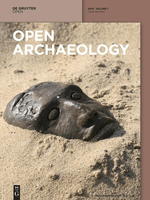
Open Archaeology
Advancing Archaeological Knowledge Through Open AccessOpen Archaeology is a distinguished open-access journal dedicated to publishing high-quality research in the fields of archaeology, conservation, and education. Since its inception in 2015, the journal has established itself under the esteemed publication of DE GRUYTER POLAND SP Z O O, experiencing rapid growth and recognition, culminating in a Q1 ranking in both Archaeology and Conservation categories as of 2023. Based in the vibrant academic environment of Poland, Open Archaeology caters to a global audience, illustrated by its Scopus rankings which position it 16th in Conservation and 69th in Archaeology, showcasing its significant impact in the arts and humanities sphere. The journal aims to foster interdisciplinary discourse and disseminate innovative research findings to enhance understanding and preservation of cultural heritage. With an unwavering commitment to open access, it encourages widespread dissemination of knowledge, making it an invaluable resource for researchers, professionals, and students alike.

Mediterranean Archaeology & Archaeometry
Connecting Scholars Across Mediterranean NarrativesMediterranean Archaeology & Archaeometry is a premier academic journal dedicated to advancing the fields of archaeology, anthropology, conservation, and history, published by UK Zhende Publishing Ltd. With its ISSN 1108-9628 and E-ISSN 2241-8121, this journal serves as a vital platform for scholars and practitioners to disseminate innovative research and findings related to the rich archaeological heritage of the Mediterranean region. It has gained remarkable recognition, achieving a Q2 ranking in anthropology and archaeology, and a Q1 classification in several categories including arts and humanities, conservation, and history as of 2023. Its impressive Scopus rankings underscore its impact, with a significant position in history (59/1760) and conservation (11/103) disciplines. Spanning years from 2008 to 2022, the journal invites open access contributions to foster collaboration and interdisciplinary dialogue among researchers, students, and professionals alike, making it an indispensable resource for those engaged in the exploration and preservation of historical narratives within the Mediterranean context.

Archaeologies-Journal of the World Archaeological Congress
Bridging Disciplines, Uncovering StoriesArchaeologies: Journal of the World Archaeological Congress is a premier academic journal published by Springer, focusing on the dynamic and interdisciplinary field of archaeology. With an ISSN of 1555-8622 and an E-ISSN of 1935-3987, this journal serves as a significant platform for the dissemination of innovative research, theory, and practice within the archaeological community. Hailed for its rigorous peer-review process, Archaeologies consistently ranks in the 74th percentile among its peers, currently holding a Q2 category placement in the field of archaeology as per the 2023 Scopus rankings. The journal publishes original articles, critical essays, and case studies that emphasize the cultural, historical, and methodological aspects of archaeological research from a global perspective. As a key resource for researchers, professionals, and students alike, Archaeologies facilitates critical dialogue and enhances understanding of humanity's past through archaeology. Although the journal is not open access, it provides various subscription options to ensure its valuable content remains accessible to its diverse audience.
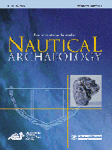
INTERNATIONAL JOURNAL OF NAUTICAL ARCHAEOLOGY
Navigating the Waters of Archaeological DiscoveryWelcome to the International Journal of Nautical Archaeology, a premier peer-reviewed publication dedicated to advancing the study of maritime history and underwater archaeology. Published by Taylor & Francis Ltd, this esteemed journal, indexed with an ISSN of 1057-2414 and an E-ISSN of 1095-9270, serves as a vital platform for researchers, professionals, and students alike. Celebrated for its rigorous scholarship, the journal ranks in the top quartile for both Archaeology and History in 2023, reflecting its influential role within the academic community. Covering a broad spectrum of topics from ancient shipwrecks to contemporary marine archaeology practices, the journal aims to foster interdisciplinary dialogues that enrich our understanding of humanity's maritime heritage. With a publication history dating back to 1972, it continues to thrive as a key resource in the field. Although currently not offering Open Access, the insights published in this journal are invaluable for those seeking to explore the intersections of archaeology and oceanography, making it a must-read for anyone engaged in or studying these dynamic disciplines.
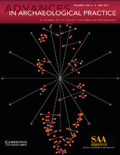
Advances in Archaeological Practice
Uncovering the Past with Cutting-Edge ResearchAdvances in Archaeological Practice, published by Cambridge University Press, is a leading journal in the field of archaeology, emphasizing innovative approaches and methodologies that advance archaeological research. With an ISSN of 2326-3768 and a commendable Q1 ranking in both the Arts and Humanities and Social Sciences categories, the journal effectively bridges theoretical perspectives and practical applications, positioning itself at the forefront of archaeological scholarship. Researchers and professionals can benefit from its high-impact content, reflected in its 93rd percentile ranking in the field, making it an essential resource for those aiming to stay abreast of the latest insights and practices. Although it operates under a subscription model, the quality and relevance of its publications ensure it plays a crucial role in shaping the discourse within the archaeological community and beyond, facilitating access to cutting-edge research that enhances our understanding of past human activities.
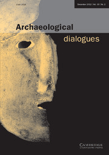
Archaeological Dialogues
Fostering Innovative Discourse in ArchaeologyArchaeological Dialogues is a premier journal published by Cambridge University Press that serves as a vital forum for innovative discourse in the field of archaeology. Established in 1994, this journal has excelled in fostering scholarly communication and is recognized with a prestigious Q1 ranking in both Archaeology and Arts and Humanities, highlighting its significant impact in these domains. With an impressive impact factor, the journal commands a strong presence in the academic community, as reflected in its Scopus rankings, where it is positioned in the top 25% for archaeology and arts and humanities disciplines. Archaeological Dialogues seeks to explore diverse perspectives and methodologies in archaeology, offering researchers, professionals, and students invaluable insights into contemporary issues and debates. While not an open-access journal, it remains accessible through institutional subscriptions, ensuring that groundbreaking research reaches a broad audience engaged in the ever-evolving landscape of archaeological study. Located in the United Kingdom, this journal not only promotes interdisciplinary connections but also plays a pivotal role in shaping the future of archaeological research and discussion.

Revue Archeologique du Centre de la France
Fostering Dialogue on Central France's Archaeological LegacyRevue Archeologique du Centre de la France is a prestigious academic journal dedicated to the field of archaeology, with a special focus on the rich historical and cultural heritage of central France. Published by FED EDITION REVUE ARCHEOLOGIQUE CENTRE FRANCE, this journal has been an open-access platform since 2004, ensuring that researchers, professionals, and students can freely access cutting-edge archaeological findings and scholarly discussions. With an acute emphasis on disseminating knowledge and fostering ongoing dialogue in archaeology, Revue Archeologique du Centre de la France serves as a vital resource for those keen to explore the complexities of French archaeological studies. Housed in Tours, this journal not only highlights regional heritage but also situates it within broader archaeological frameworks, making it an essential contribution to the field. Researchers can look forward to engaging with a diverse array of articles that cover both theoretical and applied aspects of archaeology, bolstering the understanding of our shared past.
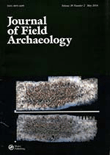
JOURNAL OF FIELD ARCHAEOLOGY
Pioneering Insights into Ancient CivilizationsJOURNAL OF FIELD ARCHAEOLOGY, published by Routledge Journals, Taylor & Francis Ltd, is a premier scholarly publication dedicated to advancing the field of archaeology. With an impressive impact factor reflecting its significant contributions to both the arts and humanities, this journal ranks in the Q1 category for archaeology, with a remarkable position of #21/413 in the arts and humanities realm and #19/354 in social sciences, placing it in the 95th percentile among its peers. Catering to researchers, professionals, and students alike, the journal has continuously explored critical archaeological questions since its inception in 1974, with a commitment to disseminating high-quality research and innovative methodologies up to the present. Although it operates under a traditional access model, the journal engages a broad readership with its insightful studies and findings, making it an essential resource for anyone deeply involved in archaeology and its related disciplines.
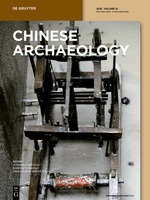
Chinese Archaeology
Charting New Territories in Eastern ArchaeologyChinese Archaeology, published by WALTER DE GRUYTER GMBH, is a leading journal dedicated to the exploration and study of China's rich archaeological heritage. With an ISSN of 2160-5025 and an E-ISSN of 2160-5068, this journal serves as an essential platform for scholars, researchers, and enthusiasts in the field of archaeology, offering a blend of original research articles, reviews, and critical essays that address both contemporary issues and historical narratives. While it currently operates under a conventional access model, making cutting-edge research available to a select audience, it plays a crucial role in advancing knowledge about China's archaeological sites, artifacts, and past civilizations. Given the increasing interest in Eastern archaeology and its significance in a global context, Chinese Archaeology is positioned as a pivotal resource for understanding and interpreting the complexities of China’s historical evolution. Researchers and academics are encouraged to contribute and engage with this vital field of study to foster greater insights and innovations.
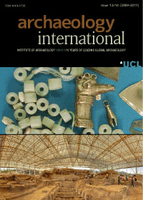
Archaeology International
Innovative insights into cultural heritage and archaeological practices.Archaeology International is a prestigious open-access journal dedicated to advancing the field of archaeology since its inception in 1997. Published by UCL PRESS, the journal provides a platform for researchers, professionals, and students to disseminate their findings and share innovative ideas in archaeological studies. It features a rich array of articles that capture current trends, methodologies, and debates within the discipline, fostering a collaborative academic environment. Based in London, England, this journal is committed to accessibility and inclusivity, ensuring that valuable research is available to a global audience without subscription barriers. With a focus on interdisciplinary approaches, Archaeology International serves as an essential resource for those interested in the preservation of cultural heritage, and it actively encourages contributions that explore both past civilizations and contemporary archaeological practices.